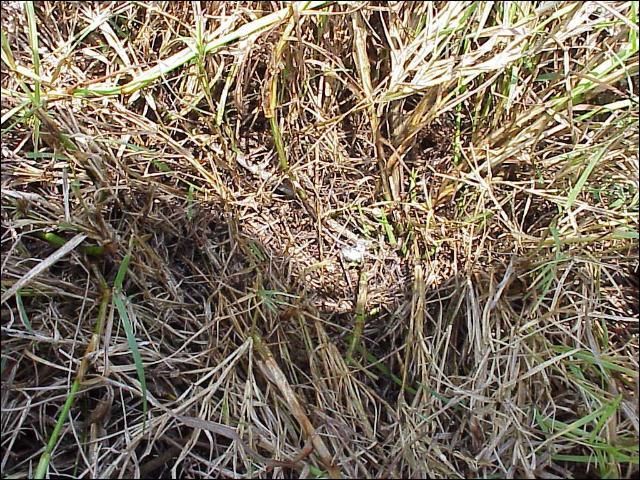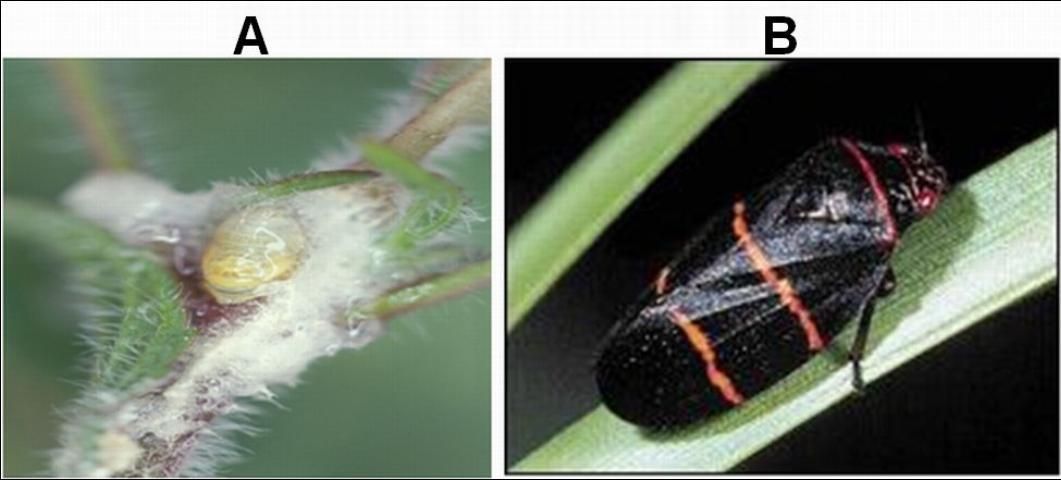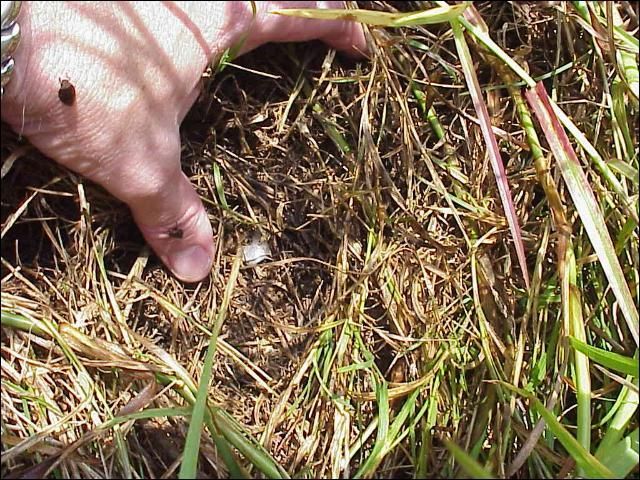The two-lined spittlebug (Prosapia bicincta Say) may cause considerable damage to 'Floralta' limpograss (Hemarthria altissima [Poir] Stapf and C.E. Hubb), bermudagrass (Cynodon spp), and St. Augustinegrass (Stenotaphrum secundatum) pastures in Florida during the summer season.
Both adults and immature or nymphs damage grasses by inserting their needle-like mouthparts and sucking plant juices. The adults also inject toxic saliva into leaf tissue while feeding, causing streaking on the leaves. Tips of infested grass turn yellow, followed by browning and curling. Heavily infested pasture turns brown, becomes unproductive and may die back in large patches (Figure 1).

Credit: Yoana Newman, UF/IFAS
Identification
The adult two-lined spittlebug is approximately 3/8 of an inch long, dark brown to black, has red legs and eyes, and gets its name from the two orange-red lines across its wings (Figure 2B). Nymphs are cream-colored with brown head and eyes. The presence of nymphs is easily identified because they are covered with a mass of froth or spittle-like material, which they produce for protection. The white, frothy masses are found at the base or crown region of the grass when opened up with the hands (Figure 3).

Credit: James Castner, Entomology and Nematology Department, University of Florida.

Credit: Yoana Newman, UF/IFAS
Life Cycle
Spittlebugs survive winter in the egg stage in hollow stems and in thatch at the base of grass. As the temperature warms, the eggs hatch in 15–19 days during spring (March–April). Nymphs begin feeding and producing frothy mass immediately. There are four nymphal instars, during which nymphs feed for 30–50 days before molting into the adult stage. On average, each adult female bug lays 45 eggs in the season. There are two, and possibly three generations of spittlebugs per year in Florida. The first-generation adults from winter egg-hatch are abundant in June. These adult spittlebugs produce eggs that hatch and turn into second-generation adults. The adult spittlebug population peaks again in early August. Eggs laid by the second-generation adults over-winter and hatch the next spring.
Spittlebug Management
No chemicals or biological agents are currently registered for control of spittlebugs on pasture. There are also no known effective natural enemies of spittlebugs. If Sevin (carbaryl) insecticide is applied to control other insect pests—such as armyworms on grasses, some suppression of adult spittlebugs will occur. However, spraying specifically to control nymphs inside the spittle mass is ineffective.
Burning off the dense mat of infested dry grass in late February or early March, followed with spring fertilization, seems to provide a means of control of spittlebugs in grass pastures. The goal of burning is to destroy eggs in the thatch of limpograss before spring growth.
After burning and fertilization, the pasture must be grazed at the beginning and throughout summer to reduce the spittlebug problem. In South Florida, towards the end of August, limpograss pastures may be fertilized and stockpiled to provide winter feed.
Spittlebugs require high humidity for optimum development. Therefore, the objective of cultural management for spittlebug control in pastures is to kill the eggs in the spring and prevent thatch accumulation during summer. However, in spring, fall, and winter, grass must be allowed to recover adequately to prevent stand loss from overgrazing or over-utilization.
No natural enemies have been identified for biological control, nor are there chemicals currently registered to control spittlebugs on pastures.
Summary
- If a pasture had a heavy infestation of spittlebugs in the previous summer, consider burning the area in January or February.
- Remember, in summer months with high rainfall, either graze or cut to a recommended stubble and store the partially dry forage in a plastic tube for haylage.
- Spraying of Sevin for armyworms may suppress adult spittlebugs, but this practice is inefficient to control the nymphs.